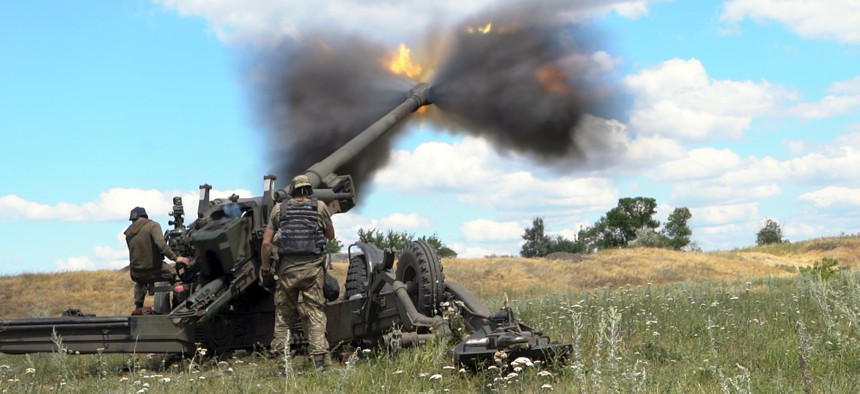US Soldiers Provide Telemaintenance as Ukrainians MacGyver Their Weapons

UKRAINE - JULY 18, 2022 - Ukrainian servicemen fire a towed howitzer in eastern Ukraine. This photo cannot be distributed in the Russian Federation. Photo credit should read Anna Opareniuk/ Ukrinform/Future Publishing via Getty Images
Milley visits Polish airbase to check on defenses, American repair crew.
A MILITARY BASE, Poland—Some four dozen U.S. troops here are helping their Ukrainian counterparts across the border fix and maintain 155mm howitzers, Javelin launders, HIMARS and other weapons. But since the Americans aren’t in Ukraine, they’re providing assistance via encrypted digital chats, sending replacement parts, and consulting on parts the Ukrainians make themselves. It’s vital work at an airbase that could be among the first targets if Russia expands the war beyond Ukraine.
With the help of some Ukrainian linguists, the U.S. maintenance specialists communicate in 14 chatrooms, one for each weapon and system the Ukrainians need help with. The Ukrainians use Starlink satellite communication terminals to share video clips as needed.
“Ukrainians are going to identify a need, the experts are going to diagnose…what's needed and either walk them through it or put parts on order. And then we use the American supply system to get that part here to transfer right down,” said one lieutenant colonel involved in the effort. (Defense One is not allowed to publish the names of the personnel involved or the name of the base.)
Some of the needs are new even to the U.S. specialists. The Ukranians have been using long-range fires like howitzers much more heavily than the United States has used such weapons in decades.
“The wear and tear on these guns is something that we just weren't ready for because of the rates that [the Ukranians] are firing these rounds. Their dependency on that field artillery system is what's keeping them in this fight,” said the colonel. “When they're firing them in this way, you're seeing trends, you're seeing common faults. They haven't been tested in this manner…because they're just, these are not [firing] numbers that the product or the program managers even use to stress us.”
For instance, the heavy use is wearing down the internal grooves of howitzer barrels, requiring frequent replacement. Other problems, such as damage from bullets or normal wear and tear the Ukranians can fix themselves.
But certain hard-to-get parts require the full spectrum of Ukrainian ingenuity. They use computer-assisted design to draw up designs, run them past U.S. specialists for guidance, and make the parts themselves.
The Ukrainains have no a direct line to U.S. weapons manufacturers and there are no U.S. personnel in the country to order replacement parts or coordinate shipments, much to the frustration of some volunteers who have journeyed to Ukraine to assist in the war effort.
There’s “zero supply on a lot of things. And so … we're not stopping to try and solve those problems. Every single gun in the fight matters,” said the colonel.
On Sunday, the base received a visit from the top U.S. officer, Joint Chiefs Chairman Gen. Mark Milley, who was in Europe this week for a meeting with NATO defense chiefs in Estonia. Milley, said his main purpose for visiting the base, which is guarded by Patriot missile batteries as well as other air defense systems, is to make sure the base is adequately protected, especially from possible Russian missile strikes. He told reporters such checks were “not an indicator of something that might happen,” and that he had no specific intelligence to suggest a threat to the base.
“I’m particularly interested in checking things like force protection to ensure that they are in an adequate state of readiness in the event of anything ever happening. It's my job,” Milley said. “It's our job; it's the commander of EUCOM’s, it's the commanders’ on the ground job to ensure that our forces are in a state of readiness at all times for whatever might happen.”
Milley again discussed the recent Ukrainian advances and said that they were an indicator that Russia had lost “strategic initiative” in the war. But that didn’t mean that the Russians were less of a threat. “I don't think [the threat of Russia to U.S. troops in Poland] is any greater or less. I just think that there's an active war going on in Ukraine….The war is not going too well for Russia right now. So it's incumbent upon all of us to maintain high states of readiness alert. You just don't know with a high degree of certainty what will happen next. So maintaining high degrees of force protection and readiness is always incumbent upon us.”



